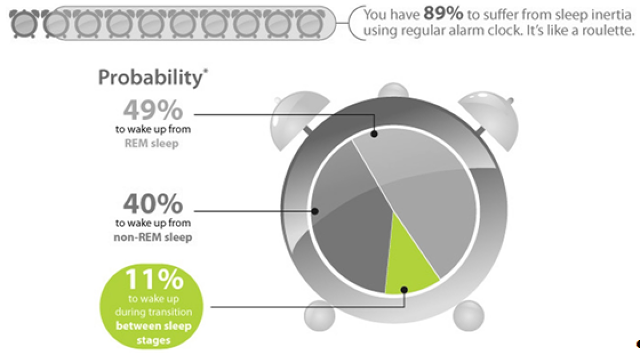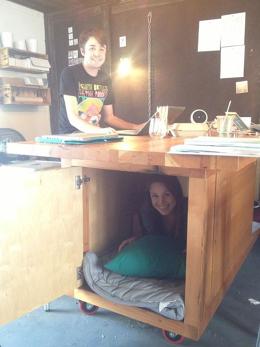Studies of napping have shown improvement in cognitive function, creative thinking, and memory performance. Ready, set . . . snooze.
I’m a big fan of afternoon naps.
In fact, I was super excited when I joined Buffer to hear that the team is pro-napping. It’s not every day you come across a company that’s open to letting employees take a snooze whenever they want one.

Naps aren’t for everyone, though. I’ve heard lots of people say naps don’t make them feel better, so I wanted to explore how naps affect your brain and whether they really are good for you or not.
Better sleeping is known to provide lots of health benefits. These can include better heart function, hormonal maintenance and cell repair as well as boosting memory and improving cognitive function. Basically, sleeping gives your body a chance to deal with everything that happened during the day, repair itself, and reset for tomorrow.
Sleep deprivation, therefore, actually harms us in several ways. One of the most obvious harms is that we have trouble focusing when we’re sleep deprived. Buffer cofounder Leo Widrich wrote about this before:
Someone who is severely sleep deprived is in fact as attentive and awake as you are. With one big difference to you. Here is what a recent study found: The sleep deprived person can in fact deliver the exact same results as someone who isn’t sleep deprived in any exercise. That is, given it is a non-repeated exercise and they give it their best shot. Odd right? Now onto this though:
The problem lies elsewhere. Whether we are sleep deprived or not, we lose focus at times. And that is precisely where the sleep deprived person lands in a trap. Once we start to lose focus and have received the right amount of sleep, our brain can compensate for that and increase attention. If we are sleep deprived, our brain can’t refocus.
Studies of napping have shown improvement in cognitive function, creative thinking, and memory performance. As I mentioned in my post about the body clock and your body’s best time for everything, we’re naturally designed to have two sleeps per day:
The idea that we should sleep in eight-hour chunks is relatively recent. The world’s population sleeps in various and surprising ways. Millions of Chinese workers continue to put their heads on their desks for a nap of an hour or so after lunch, for example, and daytime napping is common from India to Spain.
Naps can even have a physical benefit. In one study of 23,681 Greek men over six years, the participants who napped three times a week had a 37% lower risk of dying from heart disease. Not to mention a host of other positive outcomes that might occur from regular napping:
Sleep experts have found that daytime naps can improve many things: increase alertness, boost creativity, reduce stress, improve perception, stamina, motor skills, and accuracy, enhance your sex life, aid in weight loss, reduce the risk of heart attack, brighten your mood and boost memory.
Memory
Naps have been shown to benefit the learning process, helping us take in and retain information better. In one study, participants memorized illustrated cards to test their memory strength. After memorizing a set of cards, they had a 40-minute break wherein one group napped, and the other stayed awake. After the break, both groups were tested on their memory of the cards, and the group who had napped performed better:
Much to the surprise of the researchers, the sleep group performed significantly better, retaining on average 85 percent of the patterns, compared to 60 percent for those who had remained awake.

Apparently, napping actually helps our brain to solidify memories:
Research indicates that when memory is first recorded in the brain--in the hippocampus, to be specific--it’s still “fragile” and easily forgotten, especially if the brain is asked to memorize more things. Napping, it seems, pushes memories to the neocortex, the brain’s “more permanent storage,” preventing them from being “overwritten.”
Learning
Taking a nap also helps to clear information out of your brain’s temporary storage areas, getting it ready for new information to be absorbed. A study from the University of California asked participants to complete a challenging task around midday, which required them to take in a lot of new information. At around 2 p.m., half of the volunteers took a nap while the rest stayed awake.
The really interesting part of this study is not only that at 6 p.m. that night the napping group performed better than those who didn’t take a nap. In fact, the napping group actually performed better than they had earlier in the morning.
The lead researcher, Dr. Matthew Walker . . . said the findings support the idea that sleep is a necessary process that clears the brain’s short-term memory storage so there is room to absorb new information.
The same research team had found earlier that studying through the night, such as cramming the night before an exam actually decreases the brain’s ability to absorb information by almost 40%, which makes sense in light of this newer research into the effect of a nap on the brain’s learning abilities.
I love this analogy from Dr. Walker to explain the process of clearing out your brain’s storage with a nap:
Walker likened the process to having an email inbox in your hippocampus. This gets full, and you need to sleep to initiate the clearing-out process. Until you do, then the mail stays in the inbox and you can’t take in any more.
“It’s just going to bounce until you sleep and move it into another folder,” said Walker.
Dr. Walker also mentioned how these findings mean napping before learning is as important as it is afterwards:
Sleep prepares the brain like a dry sponge, ready to soak up new information.
Avoiding burnout
A study from Massachusetts showed how napping can help your brain recover from ‘burnout’ or overload of information:
To see whether napping could improve visual discrimination, a team led by Robert Stickgold, a neuroscientist at Harvard University in Cambridge, Massachusetts, had college students who were not sleep deprived stare at a video screen filled with horizontal bars. Periodically, three diagonal bars flashed in the lower left corner of the screen, and the students had to say whether these bars were stacked horizontally or vertically. The researchers graded students’ performance by measuring how long the diagonal bars had to be shown in order for them to answer correctly 80% of the time.
Students sat through 1,250 frustrating trials during each session, so those who did not nap did worse and worse over the course of the day. But students who took a 1-hour nap returned to their original performance levels in the next test.
The researchers in this study also experimented with moving the diagonal bars into different areas of the screen after several tests, which resulted in participants performing as well as they did at the beginning. Stickgold said this pointed out how quickly our brain’s visual centers become overloaded, since only three tests were enough to see a decrease in performance that could be overcome by changing the placement of visual input:
Burnout is a signal that says you can’t take in more information in this part of your brain until you’ve had a chance to sleep.
Another study showed that a 60– to 90-minute nap could be as good as a full night’s sleep for learning a visual perception skill. It seems as though our eyes are getting a lot of rest and repair when we’re asleep!
The benefits of a nap can even last for several hours, according to Professor Leon Lack from Flinders University:
Ten to 15 minutes of sleep seems to be the optimum period in terms of improving mental operations, performance, reaction times and subjective feelings of alertness. And that improvement in performance and alertness seems to be maintained for up to two and sometimes three hours after the nap. Interestingly, the five-minute nap just didn’t produce the same amount of improvement, while longer naps of 25 to 30 minutes led to subjects being somewhat drowsy and less alert for up to an hour after the nap.
Some recent research has found that the right side of the brain is far more active during a nap than the left side, which stays fairly quiet while we’re asleep. Despite the fact that 95% of the population is right-handed, with the left side of their brains being the most dominant, the right side is consistently the more active hemisphere during sleep.
The study’s author, Andrei Medvedev, speculated that the right side of the brain handles ‘housekeeping’ duties while we’re asleep. The study looked at how active various parts of the brain were while participants were sleeping:
Medvedev and his colleagues used a type of brain imaging known as near-infrared spectroscopy, which involves placing optical fibers similar to electrodes symmetrically around a person’s scalp. These “optodes” send infrared light through the brain and measure how much light returns.
The intensity of light bouncing back provides an estimate of the blood flow in different regions of the brain. Blood flow, in turn, is an indicator of how active those regions are.
So while the left side of your brain takes some time off to relax, the right side is clearing out your temporary storage areas, pushing information into long-term storage, and solidifying your memories from the day.
It’s true that I’m a big proponent of naps now, but I wasn’t always. In fact, I was once vehemently opposed to napping, because I found that I was generally groggy and felt even more tired when I woke up from a nap.
The trick, I’ve found, is to work out what kind of nap suits you best. Unfortunately, this takes a lot of trial and error, but I definitely think it’s worth it. Here are some tips to help you work out the best way to get the most from your nap:
1. Learn how long you take to fall asleep
If you’re trying to nap for a specific amount of time, you definitely need to factor in the length of time it takes you to get to sleep. If you need some help to work this out, you could try using a fitness tracker like the Jawbone UP, or a sleep-tracking app on your phone. Once you have a rough idea, you can factor this into your napping time.
When I set an alarm to wake me up from a nap, I normally set it five to 10 minutes longer than I want to sleep, since this is about how long I take to get to sleep. If I’m still awake after 15 or 20 minutes, I reset my alarm and start over. Having an alarm set lets me relax knowing that I won’t fall asleep for hours and wake up groggy around dinner time.
If you don’t want to set an alarm, you could try this trick Michael Hyatt shared on his blog:
“Every day after lunch, I lie down on the sofa in my office,” he recounted. “I hold my car keys in my right hand and let my hand hang toward the floor. When the car keys fall out of my hand, I know I’m done.” (Evidently, the famous artist Salvador Dali had a similar practice.)
2. Don’t sleep too long.
Sleeping for the wrong length of time is exactly what made me hate naps originally. The problem is that this can give you sleep inertia--that feeling of waking up groggy and even more tired than you were before.

Dr. Sara C. Mednick who wrote Take a Nap! Change Your Life says sleep inertia happens when you wake up during deep, slow-wave sleep.
Since brain temperature and blood flow to the brain decrease during this sleep stage, it’s jarring to suddenly be awake and experiencing much higher rates of brain activity.
There is no benefit to napping longer than 90 minutes, because you will only begin another sleep cycle. Further, if you take a snooze too late in the day, it will contain too much slow-wave sleep.
This how-to guide for a caffeine nap explains how troublesome sleep inertia can be:
Limit your nap to 15 minutes. A half hour can lead to sleep inertia, or the spinning down of the brain’s prefrontal cortex, which handles functions like judgment. This gray matter can take 30 minutes to reboot.

The consensus across most of the research I dug up seemed to be either to go for a short, 15– to 20-minute nap, perhaps with a cup of coffee beforehand to wake up with more energy (though I’ll be impressed if you can coordinate this!) or to sleep for a full 90-minute sleep cycle, and wake up before your next cycle starts.
3. Choose the right time of day.
Napping when your energy levels are naturally decreased can help you avoid the dreaded infinite-hour feeling, where the day drags on as you try to ignore your sleepiness. This is usually sometime after lunch for those of us who work on a traditional 9–5 schedule:
Because of the natural cycles of our circadian rhythms, we are at our most tired twice during a 24-hour period. One peak of sleepiness is usually in the middle of the night, so the other, 12 hours later, falls smack-dab in the middle of the afternoon.
If you’re sleep deprived from the night before, you’ll feel this dip in energy even more strongly and be more inclined to nap. Rather than fighting it off with energy drinks or coffee, try a short nap to refresh your brain before taking on the afternoon.
If you’re lucky enough to have a napping place in your office as we do at Buffer, or Social Print Studio’s napping boxes pictured above, you’re off to a good start already!

4. Practice
The best way I’ve found to get better at napping is to practice. Figuring out what works for you can take a while, so try experimenting with different times of the day, different nap lengths and different ways of waking up (if you’re worried about grogginess, you could try an app like Warmly, which wakes you up slowly, or a sleep-tracking app like Sleep Cycle to wake you up during light sleep).
Don’t forget to set up your napping space with as little light as possible and grab a blanket to keep you warm while you’re asleep. Good luck!














